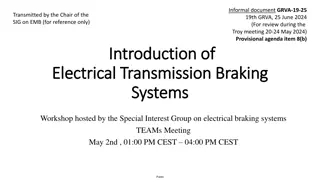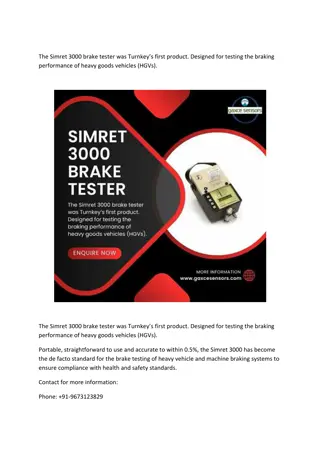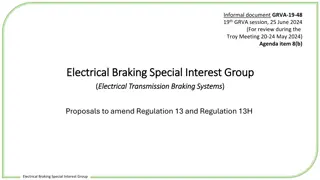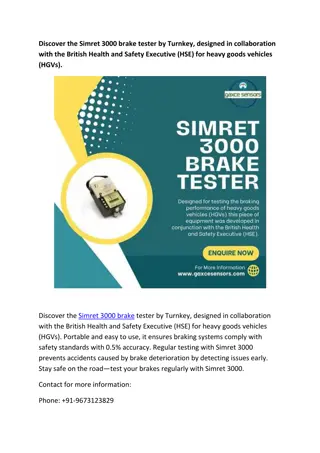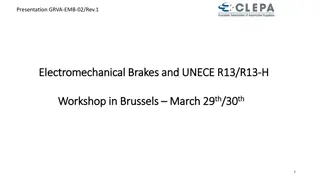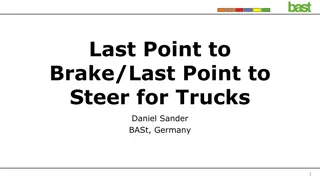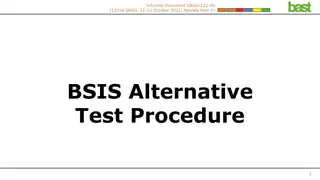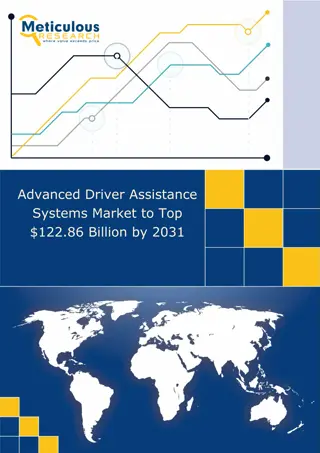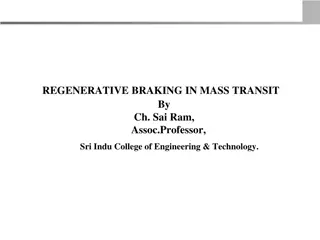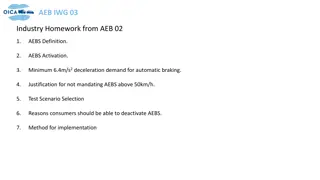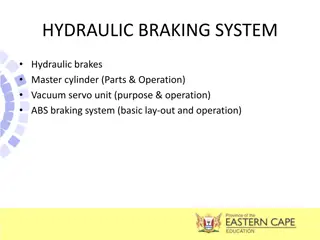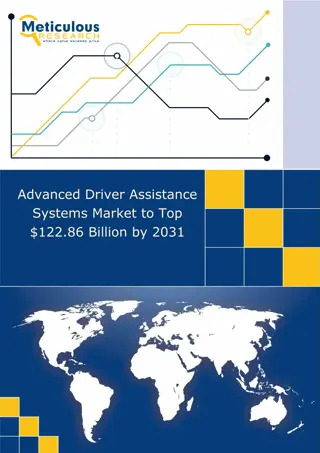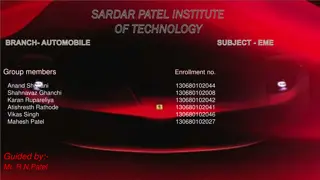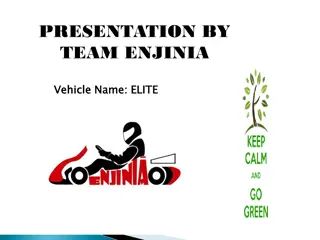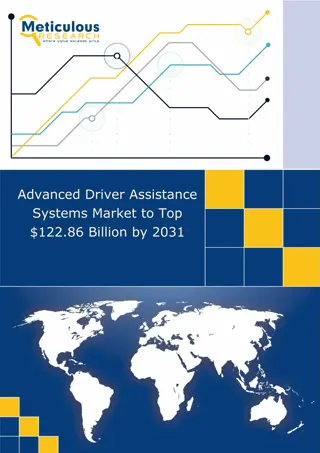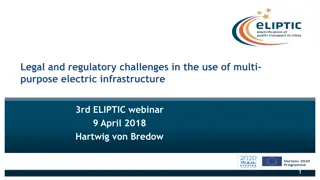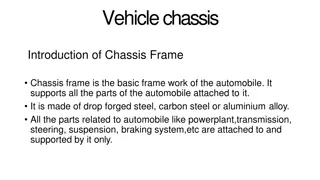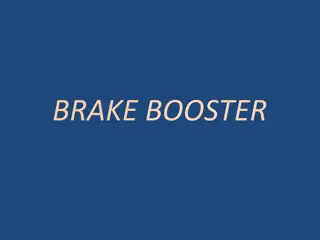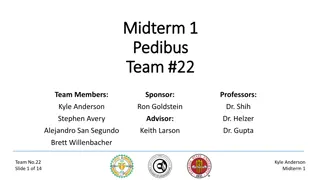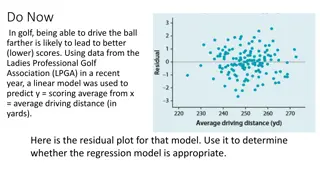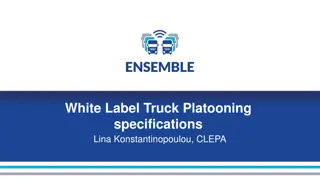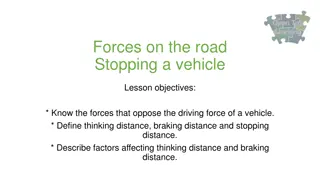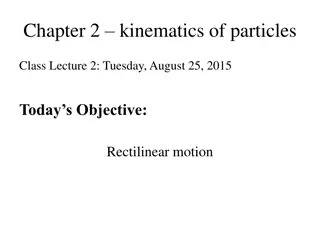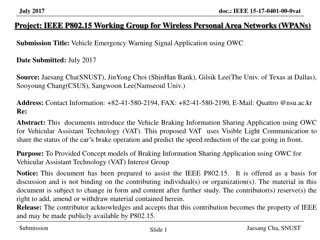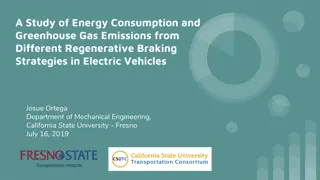Limitations and Improvements for S-EPAC Regarding ABS Efficiency
Proposed changes to the deceleration threshold in UN Regulations No. 78 to better align with the physics of S-EPACs, specifically related to Anti-lock Braking Systems (ABS) efficiency and safety enhancements for electrically powered bicycles in the EU.
5 views • 5 slides
Introduction of Electrical Transmission Braking Systems Workshop
The Special Interest Group on electrical braking systems is hosting a workshop to discuss the drafting principles, terminology, and indicators related to electrical transmission braking systems. The workshop aims to identify safety critical elements, propose amendments to UN Regulations, and make re
1 views • 29 slides
The Simret 3000 brake tester was Turnkey’s first product
\n\nThe Simret 3000 brake tester was Turnkey\u2019s first product. Designed for testing the braking performance of heavy goods vehicles (HGVs).\nPortable, straightforward to use and accurate to within 0.5%, the Simret 3000 has become the de facto standard for the brake testing of heavy vehicle and m
1 views • 2 slides
Proposal to Amend Regulations for Electrical Transmission Braking Systems
The document covers proposals to amend Regulation 13 and Regulation 13H for electrical braking systems, focusing on electrical transmission braking systems. It discusses changes in requirements, provisions, and special additional requirements, along with workshops and meetings by the Electrical Brak
0 views • 15 slides
Discover the Simret 3000 brake tester by Turnkey
\n\nDiscover the Simret 3000 brake tester by Turnkey, designed in collaboration with the British Health and Safety Executive (HSE) for heavy goods vehicles (HGVs). Portable and easy to use, it ensures braking systems comply with safety standards with
1 views • 2 slides
Advancements in Electromechanical Brakes for Vehicles Presented at Workshop in Brussels
Overview of new technical concepts and the scope of Electro-Mechanical Brakes (EMB) amendment, focusing on electric transmission and energy efficiency improvements. The presentation covers the motivation, advantages, and principles of EMB, emphasizing the elimination of noise emissions, improved bra
0 views • 37 slides
Performance Requirements Derivation for Truck Braking and Steering
Daniel Sander from BASt, Germany, introduces a method to derive performance requirements from basic principles in the context of Last Point to Brake/Last Point to Steer for Trucks. The goal is to break down the definition of AEBS performance into key parameters, as exemplified in AEBS-M1-N1 for R152
0 views • 21 slides
Proposal to Amend PBC Reference for AEBS in Vehicles
The proposal aims to update the Peak Braking Coefficient (PBC) reference for Advanced Emergency Braking Systems (AEBS) in vehicles by adopting newer methods that consider the improved tire technology and road conditions. It suggests using updated ASTM standards and testing methods to align PBC value
0 views • 5 slides
Alternative Test Procedure for Ensuring Driver Awareness of Endangered Bicyclists
GRSG-122-20 discusses Regulation 151-00, highlighting the need for timely information to drivers of heavy vehicles regarding nearby bicyclists. The main criticism addressed is the early signaling issue, proposing a new alternative test procedure for verifying Advanced Emergency Braking Systems. The
0 views • 39 slides
Advanced Driver Assistance Systems Market to Top $122.86 Billion by 2031
Meticulous Research\u00ae\u2014a leading global market research company, published a research report titled,\n \u2018ADAS Market by Type (Blind Spot Detection Systems, Automatic Emergency Braking Systems), Automation \n(Level 1, 2, and 3), Component
0 views • 3 slides
Understanding Electric Braking Systems
Braking is the process of reducing the speed of moving or rotating equipment, such as vehicles or locomotives. This presentation by Poonam Sharma covers the classification of braking into Mechanical and Electrical categories, highlighting the advantages and disadvantages of each. It delves into type
0 views • 28 slides
Regenerative Braking in Mass Transit: Harnessing Energy Efficiency
Regenerative braking in mass transit is an energy recovery mechanism that slows down vehicles while converting the generated power for immediate use, storage, or redistribution. This technology, while not entirely new, offers opportunities for increased energy efficiency, reduced maintenance costs,
3 views • 11 slides
Advanced Emergency Braking System (AEBS) Definition and Activation Guidelines
The provided content outlines the definition and activation requirements of the Advanced Emergency Braking System (AEBS). It covers the phases involved, including Collision Warning and Emergency Braking, as well as the speed limitations for activation. The system aims to automatically detect potenti
0 views • 12 slides
Understanding Hydraulic Braking Systems in Vehicles
Hydraulic braking systems play a crucial role in controlling the speed and stopping vehicles safely. Components such as master cylinders, tandem cylinders, and vacuum servo units work together to ensure efficient braking performance. The system's construction includes calibrated springs and outlet v
4 views • 20 slides
Advanced Driver Assistance Systems Market Forecast to Achieve $122.86 Billion by
Meticulous Research\u00ae\u2014a leading global market research company, published a research report titled, \u2018ADAS Market by Type (Blind Spot Detection Systems, Automatic Emergency Braking Systems), Automation (Level 1, 2, and 3), Component (Vis
0 views • 3 slides
Understanding Clutches and Brakes in Automobile Engineering
Explore the essential components of clutches and brakes in automobile systems, including types, construction, and purpose. Learn about the role of clutches in disengaging the engine from transmission for gear shifting and braking, and discover various types of clutches like pneumatic, hydraulic, mec
3 views • 25 slides
Team Enjinia Vehicle Design Presentation
Team Enjinia presents their vehicle design project named "ELITE" with a focus on chassis, steering, braking system, power source, and transmission analysis. The team embraces innovative technologies like rack and pinion steering and disc brakes to enhance performance and safety. Detailed impact anal
0 views • 14 slides
Advanced Driver Assistance Systems Market to Achieve $122.86 Billion Valuation b
Meticulous Research\u00ae\u2014a leading global market research company, published a research report titled, \u2018ADAS Market by Type (Blind Spot Detection Systems, Automatic Emergency Braking Systems), Automation (Level 1, 2, and 3), Component (Vis
0 views • 3 slides
Legal and Regulatory Challenges in Multi-Purpose Electric Infrastructure
The use of multi-purpose electric infrastructure presents legal and regulatory challenges in connecting the energy and public transport sectors. Uncertainties in current energy laws, complex requirements, and exposure to multiple taxation pose risks. This webinar explores interactions between public
0 views • 20 slides
Physics Work and Energy Quiz Questions
This quiz contains multiple-choice physics questions related to work, energy, kinetic energy, potential energy, and forces. It covers scenarios like circular motion, kinetic energy changes, braking distances, skier motion, gravitational potential energy, and more, challenging students' understanding
0 views • 8 slides
Understanding Automobile Chassis: Frame, Operating Conditions, and Components
The chassis frame is a crucial component of an automobile, supporting all attached parts like the powerplant, transmission, steering, suspension, and braking system. It undergoes loading conditions such as vertical bending, longitudinal torsion, lateral bending, and horizontal lozenging. Various car
0 views • 95 slides
Understanding the Physics of Yellow Change Interval at ITE International Convention
Delve into the intricate details of the physics behind the yellow change interval at the ITE International Convention. Explore the critical points, braking points, comfortable stopping distances, and the concept of unimpeded through movements. Learn about the equation for turning vehicles decelerati
0 views • 14 slides
Understanding Brake Boosters in Automobile Vehicles
Brake boosters are essential components in power brake systems, enhancing braking power with minimal pedal pressure. A malfunctioning booster can make the brake pedal hard to push. Constructed with five parts, the booster utilizes pressure differentials to aid braking. Various types of boosters are
0 views • 6 slides
Design Overview of Midterm Project Team No. 22 - Pedibus
Midterm presentation slides provide insights into the design phase progress for Team No. 22's Pedibus project. Key elements include design requirements, current design features, chassis construction considerations, steering requirements, drivetrain details, and wheels and brakes specifications. The
0 views • 14 slides
Understanding Applications of Pneumatics in Various Devices
Explore the common theme of pneumatics among five different clips showcasing applications such as office chair, bus braking system, bicycle pump, bus door, and can crusher. Discover the origin and usage of pneumatics in physics, industries, and other areas, including components like cylinders, regul
0 views • 5 slides
Analyzing Residual Plots for Regression Model Appropriateness in Golf
Utilizing residual plots to evaluate the appropriateness of a linear regression model predicting scoring average from average driving distance in golf based on LPGA data. Introduction to quadratic and exponential models, with an example exploring the relationship between braking distance for motorcy
0 views • 15 slides
Overview of White Label Truck Platooning Specifications
White Label Truck Platooning involves driving trucks at short inter-vehicle distances for extended periods, creating a system of interconnected systems with specific requirements. The driver cannot be solely responsible for immediate intervention during critical events, necessitating a unique automa
0 views • 8 slides
Understanding Forces and Stopping Distances in Vehicle Safety
Explore the forces that oppose vehicle motion, and learn about thinking distance, braking distance, and stopping distance. Discover how factors affect these distances, such as friction and reaction time. Gain insights into how friction helps in braking systems and the impact of accelerating or braki
0 views • 16 slides
Kinematics of Particles: Understanding Motion in Physics
Explore the concepts of rectilinear motion, analytical relationships of velocity and acceleration, and solve practical problems involving acceleration and distance calculations in physics. Dive into scenarios such as a car race, a baseball player running to first base, and a subway train braking bet
0 views • 8 slides
Vehicle Emergency Warning Signal Application Using OWC for Vehicular Assistant Technology
Introducing a concept model for a Vehicular Assistant Technology application that utilizes Visible Light Communication to share braking information among vehicles. This proposed system aims to enhance safety by predicting and sharing brake operation statuses. The application is designed to prevent c
0 views • 4 slides
Study on Regenerative Braking Effects in Electric Vehicles
Investigating the impact of regenerative braking strategies on energy consumption and greenhouse gas emissions in electric vehicles, this study by Josue Ortega from California State University - Fresno delves into improving regenerative braking system performance through data analysis and calculatio
0 views • 18 slides

